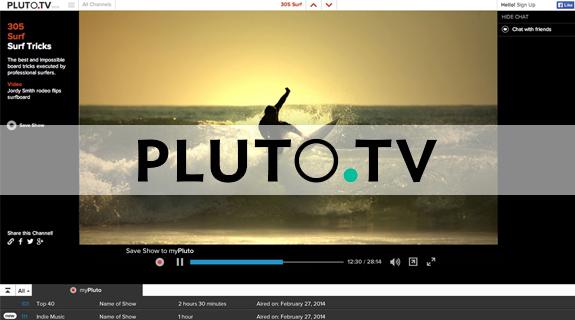Like looking out into the vast, unending cosmos, it can be overwhelming to contemplate the teeming ocean of video floating on the Internet at all times, swelling incomprehensibly in size every second. Sure, we know good stuff is out there, but the idea of actually finding it seems pretty improbable.
So, we let chance lead the way, watching clips that have been shared by friends or other sources, or seeking it out ourselves. Both pursuits are starkly different consumption approaches than traditional TV viewing, where available content is clearly demarcated and access to it a simple choice of yes or no. But a streaming app called Pluto.TV is fixing to bridge the gap.
There have been plenty of attempts to systemize online video, mostly involving entities working to curate and package clips into sequences with arcs that create at least a semblance of an episode of TV (if not in narrative, at least in theme). Pluto.TV’s great innovation is to not only do that on a grand scale, but to program and present the resulting material exactly like network television, via an interface that looks exactly like what you’d see on any cable box, with more than 100 free channels scrolling neatly in numerical order beneath the main video window. Paired with a schedule of upcoming episodes, a non-discerning viewer might even mistake this service for cable, until they noticed channels with names such as “Cats 24/7,” “Real Estate” and “Weird Al Yankovic.”
.jpg)
People tend to watch around 3 minutes worth of Internet videos at a stretch, and usually in piecemeal fashion. Pluto.TV, said company CEO and co-founder Tom Ryan, “solves a pain point where in one app you can have access to a lot of great content across a variety of different subjects, but you’re not having to hunt and peck and find your way around.” And, each sequence of videos has been compiled not by machine/algorithm but by a full-time human curator who happens to be an expert in whatever theme or subject clips are being sequenced for.
“We’re doing the work for our user by taking the best content in that category and creating a whole that is greater than the sum of its parts,” said Ryan. “You can think of it in some ways [as] a mixed tape. You’re creating a playlist but you’re also very careful about what song precedes another song and you’re creating a title and artwork. Our curators take the same care.”
Where automated sequencing works well for music and text, Ryan said that video is too nuanced for machines to do all the work: “Unlike a song, which you listen to hundreds of times if you like it, you’re unlikely to watch the same video more than once or twice.” Creating a unique, well-packaged viewing experience every time out that also happens to be thematically connected is not a task well-suited to robots (at least not yet.)
Pluto.TV began its life as an app for desktop and Android and iOS devices, but last week moved into the smart TV realm via Amazon Fire TV. There, its TV-like platform goes toe-to-toe with such heavyweights as Netflix and Hulu Plus, though Ryan doesn’t see its service as being competitive with linear episodic TV but rather complimentary. “We’re also serving up traditional content through our platform and a good amount of that is on TV as well,” he said. “Working with great TV content producers is absolutely something we’d be excited to do.”
In a chat with Forbes, Pluto.TV co-founder Nick Grouf even suggested premium offerings might be on the way in addition to its free ad-supported model, with the possibility of subscribing to a single cable channel’s broadcast feed through the app. Of course, tectonic plates would have to shift for the service to become the a la carte option that studies show cable customers desire. But at least through Pluto, one can imagine how those plates might be shifted.
Tags:













































__twocolumncontent.jpg)











